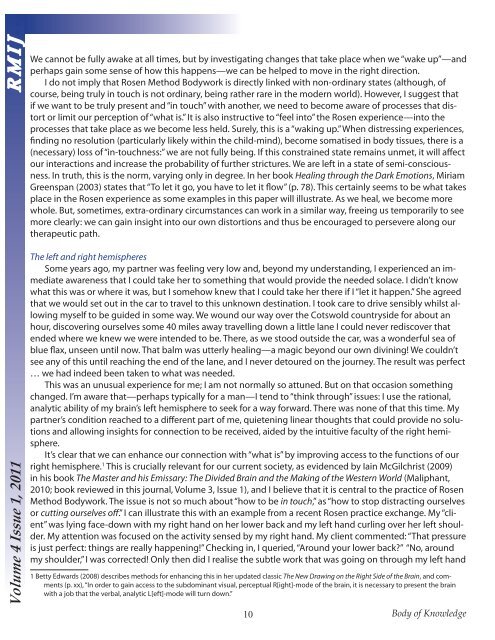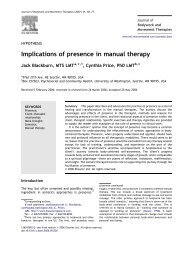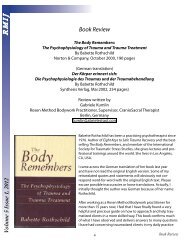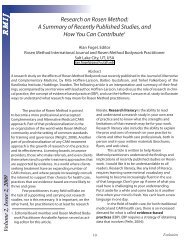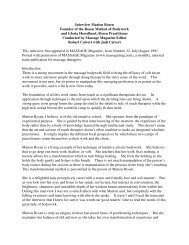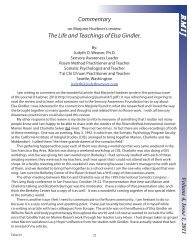R M I J ... Volume 4 Issue 1, 2011 - Rosen Journal
R M I J ... Volume 4 Issue 1, 2011 - Rosen Journal
R M I J ... Volume 4 Issue 1, 2011 - Rosen Journal
You also want an ePaper? Increase the reach of your titles
YUMPU automatically turns print PDFs into web optimized ePapers that Google loves.
R M I J . . .<br />
<strong>Volume</strong> 4 <strong>Issue</strong> 1, <strong>2011</strong><br />
We cannot be fully awake at all times, but by investigating changes that take place when we “wake up”—and<br />
perhaps gain some sense of how this happens—we can be helped to move in the right direction.<br />
I do not imply that <strong>Rosen</strong> Method Bodywork is directly linked with non-ordinary states (although, of<br />
course, being truly in touch is not ordinary, being rather rare in the modern world). However, I suggest that<br />
if we want to be truly present and “in touch” with another, we need to become aware of processes that distort<br />
or limit our perception of “what is.” It is also instructive to “feel into” the <strong>Rosen</strong> experience—into the<br />
processes that take place as we become less held. Surely, this is a “waking up.” When distressing experiences,<br />
finding no resolution (particularly likely within the child-mind), become somatised in body tissues, there is a<br />
(necessary) loss of “in-touchness:” we are not fully being. If this constrained state remains unmet, it will affect<br />
our interactions and increase the probability of further strictures. We are left in a state of semi-consciousness.<br />
In truth, this is the norm, varying only in degree. In her book Healing through the Dark Emotions, Miriam<br />
Greenspan (2003) states that “To let it go, you have to let it flow” (p. 78). This certainly seems to be what takes<br />
place in the <strong>Rosen</strong> experience as some examples in this paper will illustrate. As we heal, we become more<br />
whole. But, sometimes, extra-ordinary circumstances can work in a similar way, freeing us temporarily to see<br />
more clearly: we can gain insight into our own distortions and thus be encouraged to persevere along our<br />
therapeutic path.<br />
The left and right hemispheres<br />
Some years ago, my partner was feeling very low and, beyond my understanding, I experienced an immediate<br />
awareness that I could take her to something that would provide the needed solace. I didn’t know<br />
what this was or where it was, but I somehow knew that I could take her there if I “let it happen.” She agreed<br />
that we would set out in the car to travel to this unknown destination. I took care to drive sensibly whilst allowing<br />
myself to be guided in some way. We wound our way over the Cotswold countryside for about an<br />
hour, discovering ourselves some 40 miles away travelling down a little lane I could never rediscover that<br />
ended where we knew we were intended to be. There, as we stood outside the car, was a wonderful sea of<br />
blue flax, unseen until now. That balm was utterly healing—a magic beyond our own divining! We couldn’t<br />
see any of this until reaching the end of the lane, and I never detoured on the journey. The result was perfect<br />
… we had indeed been taken to what was needed.<br />
This was an unusual experience for me; I am not normally so attuned. But on that occasion something<br />
changed. I’m aware that—perhaps typically for a man—I tend to “think through” issues: I use the rational,<br />
analytic ability of my brain’s left hemisphere to seek for a way forward. There was none of that this time. My<br />
partner’s condition reached to a different part of me, quietening linear thoughts that could provide no solutions<br />
and allowing insights for connection to be received, aided by the intuitive faculty of the right hemisphere.<br />
It’s clear that we can enhance our connection with “what is” by improving access to the functions of our<br />
right hemisphere. 1 This is crucially relevant for our current society, as evidenced by Iain McGilchrist (2009)<br />
in his book The Master and his Emissary: The Divided Brain and the Making of the Western World (Maliphant,<br />
2010; book reviewed in this journal, <strong>Volume</strong> 3, <strong>Issue</strong> 1), and I believe that it is central to the practice of <strong>Rosen</strong><br />
Method Bodywork. The issue is not so much about “how to be in touch,” as “how to stop distracting ourselves<br />
or cutting ourselves off.” I can illustrate this with an example from a recent <strong>Rosen</strong> practice exchange. My “client”<br />
was lying face-down with my right hand on her lower back and my left hand curling over her left shoulder.<br />
My attention was focused on the activity sensed by my right hand. My client commented: “That pressure<br />
is just perfect: things are really happening!” Checking in, I queried, “Around your lower back?” “No, around<br />
my shoulder,” I was corrected! Only then did I realise the subtle work that was going on through my left hand<br />
1 Betty Edwards (2008) describes methods for enhancing this in her updated classic The New Drawing on the Right Side of the Brain, and comments<br />
(p. xx), “In order to gain access to the subdominant visual, perceptual R[ight]-mode of the brain, it is necessary to present the brain<br />
with a job that the verbal, analytic L[eft]-mode will turn down.”<br />
10<br />
Body of Knowledge


